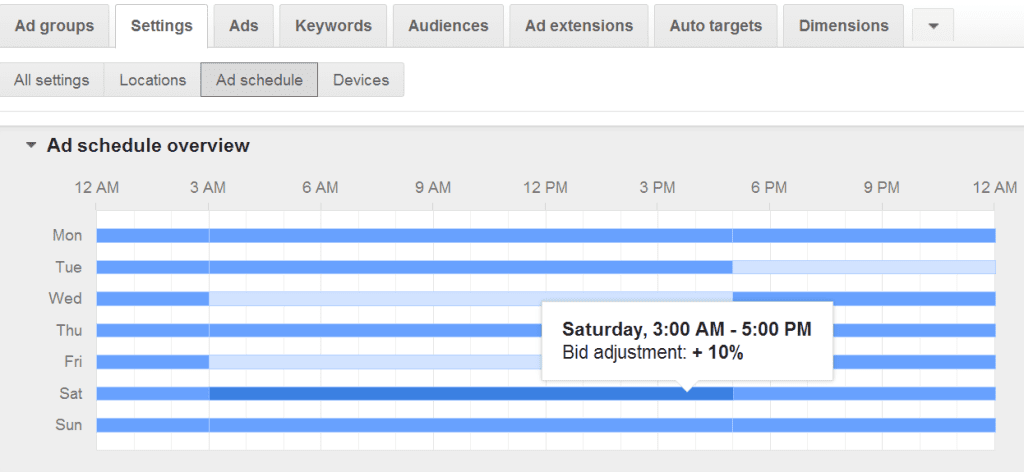 Scheduling your ads in AdWords is not an entirely new concept for most retailers. Anyone who has been using AdWords for a few years should be familiar with the campaign settings that allow you to adjust your bids based on the hours of day and days of the week. However, ad scheduling is more than turning on (or off) your ads during business hours. In fact, since your website is on 24/7, your AdWords ad scheduling should be based on your shoppers’ online shopping habits instead of your store hours.
Scheduling your ads in AdWords is not an entirely new concept for most retailers. Anyone who has been using AdWords for a few years should be familiar with the campaign settings that allow you to adjust your bids based on the hours of day and days of the week. However, ad scheduling is more than turning on (or off) your ads during business hours. In fact, since your website is on 24/7, your AdWords ad scheduling should be based on your shoppers’ online shopping habits instead of your store hours.
There is validity in connecting with your customers at the right time, the right place, and via the right device. Many factors can affect when a shopper makes a purchase on your site, however.
Imagine losing sales because your target audience shops early in the morning before work or late at night after the kids go to sleep. Since you scheduled your ads to show only between 9am and 6pm, these key shopping hours are lost opportunity. Conversely, without any ad scheduling bid adjustments you could be spending way too much at 3am for an audience who has no intent on buying. This can quickly waste your marketing dollars.
According to our Director of Paid Search, our retail clients tend to see the highest transactions during the hours of 5am and 10pm. Plus, Mondays and Tuesdays tend to produce the most transactions.
Scheduling your ads should not be as subjective as setting bids based on these general trends, however. To get ad scheduling right, consider the ABC’s of ad scheduling so you don’t miss out on key opportunities or overpay for the times when shoppers aren’t ready to buy.
A. Access the data – There is a ton of data at your fingertips in AdWords. Leverage it intelligently. For ad scheduling, run two different Dimension tab reports – 1) Day of the Week, and 2) Hour of day. Each of these reports will show you the times and days when you are making the most sales.
B. Bid according to profitability – Take the information from the Dimensions tab reports and make bid adjustments that reflect the performance data. For times or days when you have more sales, bid up. For days and times when you have no sales, bid down.
C. Consider other scheduling opportunities – Did you know you can schedule your call extensions and sitelinks? Scheduling call extensions is ideal for retailers who have set hours for their customer service team. Use scheduling to show your phone number only during the hours when a live person can answer the phone. Scheduling ad extensions is a smart retail tactic for special promotions that have set start and stop dates on your promotional calendar.
A New Scheduling Feature
A new graph format on the Ad Scheduling tab in your campaign settings will show you which hours and days have bid adjustments in an easy-to-understand format. You can even click on a set of boxes to see at a glance how much you’ve already adjusted bids for those times.

One of the biggest benefits for using AdWords is the ability to see a direct result for your online marketing efforts, then being able to ‘pour fuel on the fire’ of the strategies that are already working to generate sales.
Ad scheduling is one of the tools Google AdWords uses to allow you to leverage the platform to be more profitable. So don’t just ignore this feature and leave your ad schedules set to the default of 100% bids 24/7. This is sure to kill your AdWords profitability.
Learn more about the 10 default settings that kill retailer profitability in our most popular special report.



